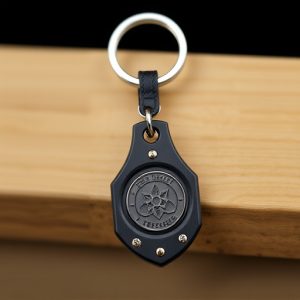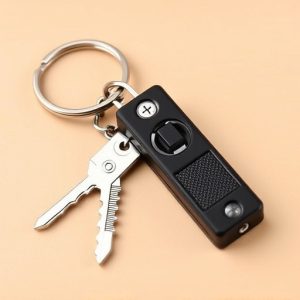Self-Defense Keychain: Legalities, Features, and Best Practices by State
Understanding your state's Self-Defense Keychain Laws is crucial before carrying such a device…….
Understanding your state's Self-Defense Keychain Laws is crucial before carrying such a device for personal safety, as laws vary widely across the US. Keychains have evolved from basic tools to sophisticated devices with GPS tracking and panic alerts. When choosing one, prioritize functionality and legal compliance, opting for models with active alarms, flashlights, and easy deployment methods. Stay informed about local regulations like California's stringent requirements or Texas' broader permissions to ensure legality while enhancing personal security.
“Unveiling the Power of Self-Defense at Your Fingertips: A Comprehensive Guide.
In today’s diverse world, being prepared for unforeseen emergencies is paramount. One innovative solution gaining traction is the self-defense keychain—a compact yet potent tool designed to offer safety and peace of mind. This article explores the legal landscape of self-defense keychains across the US, their evolving features, and crucial considerations when choosing a legal and effective defense device. From state-specific regulations to best practices, discover how these tiny tools can empower you.”
- Understanding Self-Defense Keychain Laws: A Comprehensive Guide
- The Evolution of Emergency Keychain Devices
- Features to Look for in a Legal and Effective Self-Defense Keychain
- State-by-State Analysis: Exploring Legalities and Regulations
- Best Practices for Carrying and Using Your Self-Defense Keychain
Understanding Self-Defense Keychain Laws: A Comprehensive Guide
Knowing and understanding the self-defense keychain laws in your state is crucial before considering carrying such a device for personal safety. Self-defense keychains, often equipped with tools like pepper spray or emergency alarm functions, are designed to provide individuals with a quick means of protection during potential threats. However, their legality varies significantly across different states in the US. The Self-Defense Keychain Laws by State represent a patchwork of regulations, with some states explicitly allowing them while others prohibit such devices under various circumstances.
For instance, certain states have specific requirements regarding the type of tools permitted, minimum age restrictions, and even where these keychains can be carried. Some states might allow self-defense keychains only for individuals with a concealed carry permit, while others may have exceptions for self-defense purposes without requiring a license. Staying informed about these laws is essential to ensure compliance and avoid legal repercussions.
The Evolution of Emergency Keychain Devices
The concept of an emergency keychain has evolved significantly over time, transforming from a simple tool to a sophisticated device designed to enhance personal safety. Historically, self-defense keychains were primarily focused on physical protection, often equipped with sharp blades or spikes for deterrence. However, as societal needs changed and awareness grew regarding various emergencies, these devices began to incorporate advanced features. Modern emergency keychains are not just about self-defense; they offer a wide range of tools tailored to diverse scenarios. From GPS tracking and panic alerts to automated calls for help, these keychains have become versatile life-saving tools.
The integration of technology has played a crucial role in this evolution. With varying Self Defense Keychain Laws by State, consumers now have access to devices that can discretely alert authorities or loved ones during emergencies. These innovations ensure that individuals carrying such keychains are prepared for unexpected situations, be it a personal emergency or a public safety concern. As technology advances, we can expect even more sophisticated and life-enhancing features in the future, solidifying the keychain’s place as an indispensable accessory for modern living.
Features to Look for in a Legal and Effective Self-Defense Keychain
When considering a self-defense keychain, it’s crucial to look beyond its aesthetic appeal and focus on features that ensure its legality and effectiveness. The key is to find a device that combines utility with compliance, respecting Self Defense Keychain Laws by State. One essential aspect is the inclusion of an active alarm system; a loud, attention-grabbing alarm can deter potential attackers and alert nearby help. Additionally, look for models equipped with a built-in flashlight. Not only does this provide visibility in emergency situations, but it also serves as a secondary deterrent when combined with the alarm.
Another critical feature to consider is the ease of use. The keychain should be designed for quick deployment; you want to be able to activate it instinctively during a dangerous encounter. Look for models that offer various activation mechanisms, such as a simple press or twist, ensuring you can use it even in moments of fear or stress. Moreover, check if the device comes with a sturdy clip, allowing you to attach it securely to your keys or bag, making it readily accessible when needed.
State-by-State Analysis: Exploring Legalities and Regulations
In the United States, the legalities and regulations surrounding self-defense keychains vary significantly from state to state. Understanding these laws is crucial for consumers looking to invest in such a device for personal safety. Some states have strict regulations on the type of self-defense tools allowed, while others offer broader protections. For instance, California has stringent restrictions on all self-defense devices, including keychains, requiring them to be registered and limiting their use to specific situations. In contrast, Texas has relatively lenient laws, allowing a wide range of self-defense tools without permit or registration requirements.
When exploring Self Defense Keychain Laws by State, it’s essential to consider the specific statute sections that govern these devices. Some states categorize them as weapons, subject to the same regulations as firearms, while others treat them as personal safety tools with more flexible rules. As laws can change over time, it’s advisable for consumers to consult their state’s latest legislation and seek legal advice if necessary. This comprehensive analysis ensures individuals stay within legal boundaries while enhancing their personal security.
Best Practices for Carrying and Using Your Self-Defense Keychain
When carrying a self-defense keychain, adhering to best practices ensures its effectiveness and legality. Always keep it easily accessible yet discreetly hidden. Many keychains are designed to be attached to your keys or bag, making them readily available in an emergency. Familiarize yourself with local Self Defense Keychain Laws by State, as regulations vary widely. In some states, carrying a self-defense tool is legal if used for personal protection, while others may have restrictions on the type of device allowed.
Proper usage involves understanding your keychain’s features and range. Practice activating the emergency functions until you’re comfortable with their deployment. Keep in mind that these devices are meant to deter an attack and provide a momentary escape, not replace professional self-defense training or law enforcement response. Regularly inspect your keychain for any signs of wear or malfunction, ensuring its reliability when needed most.
In light of the varying Self-Defense Keychain Laws by state, it’s crucial to be informed and prepared. The evolution of emergency keychain devices has led to a range of options, each with unique features designed for legal and effective self-defense. Understanding your local regulations and following best practices will ensure you’re using your self-defense keychain responsibly and safely. Stay informed, stay prepared – know your rights, know your tools, and be ready to protect yourself in an emergency.


